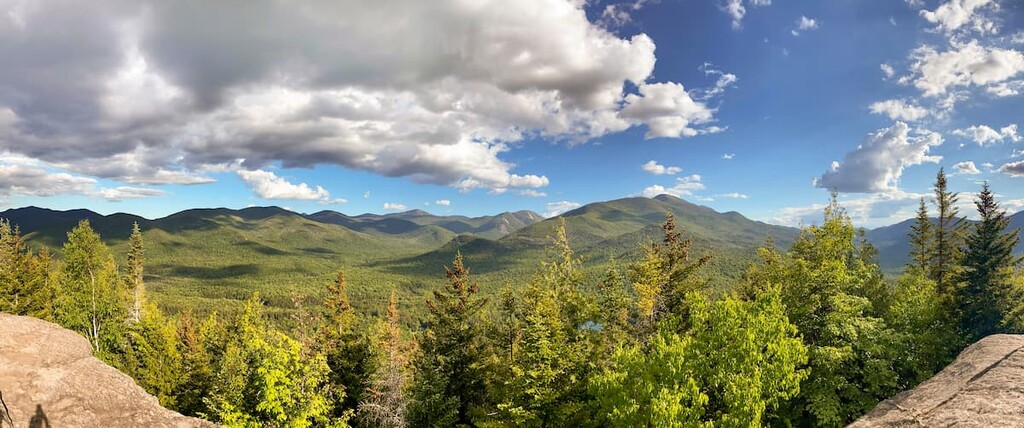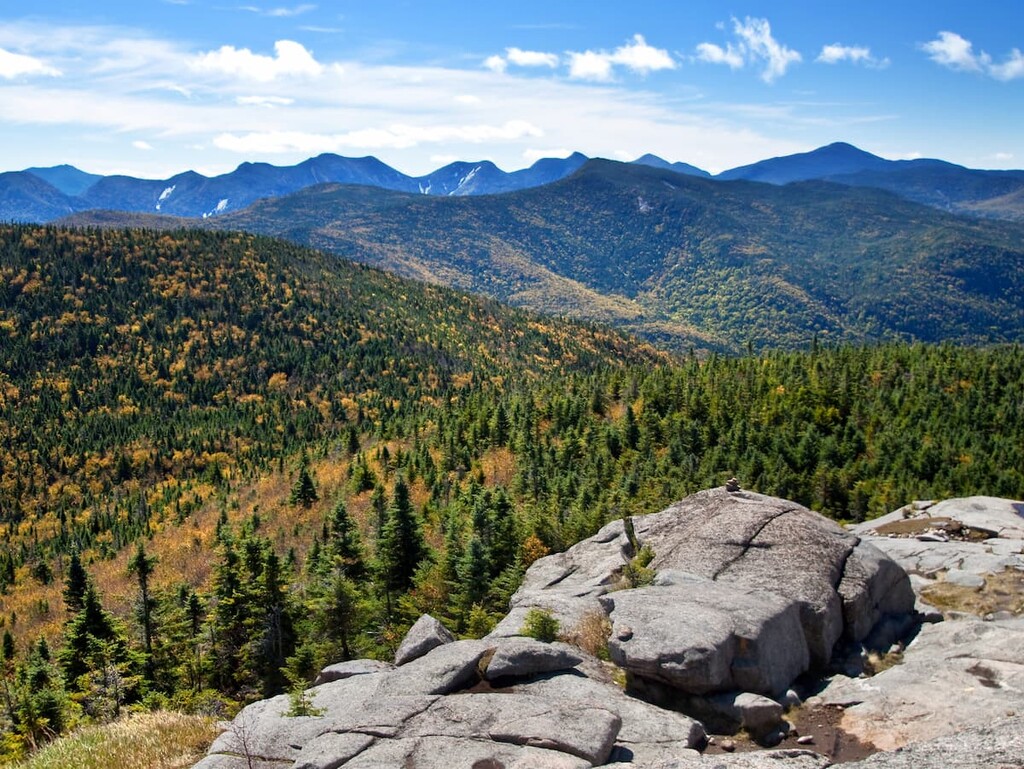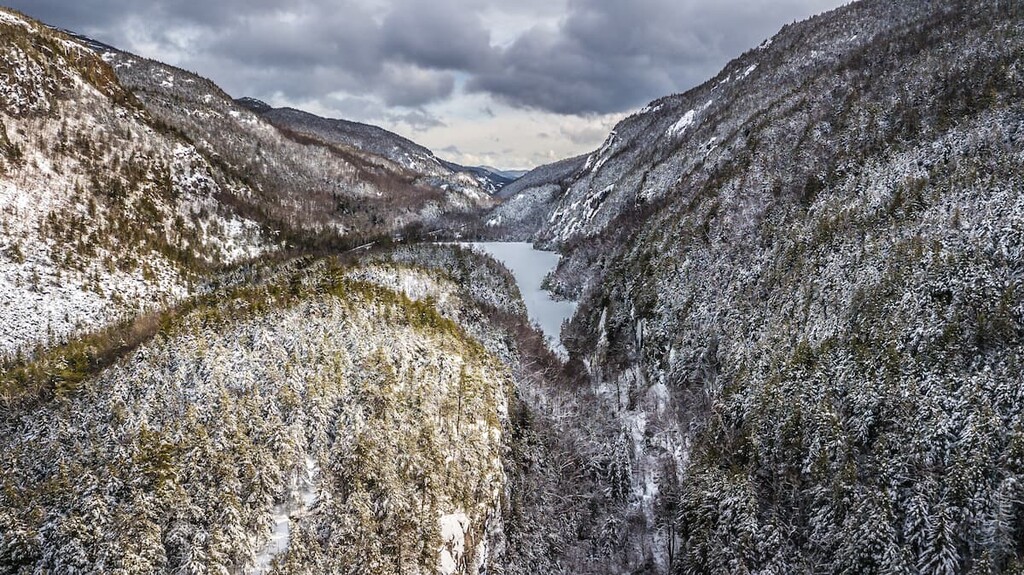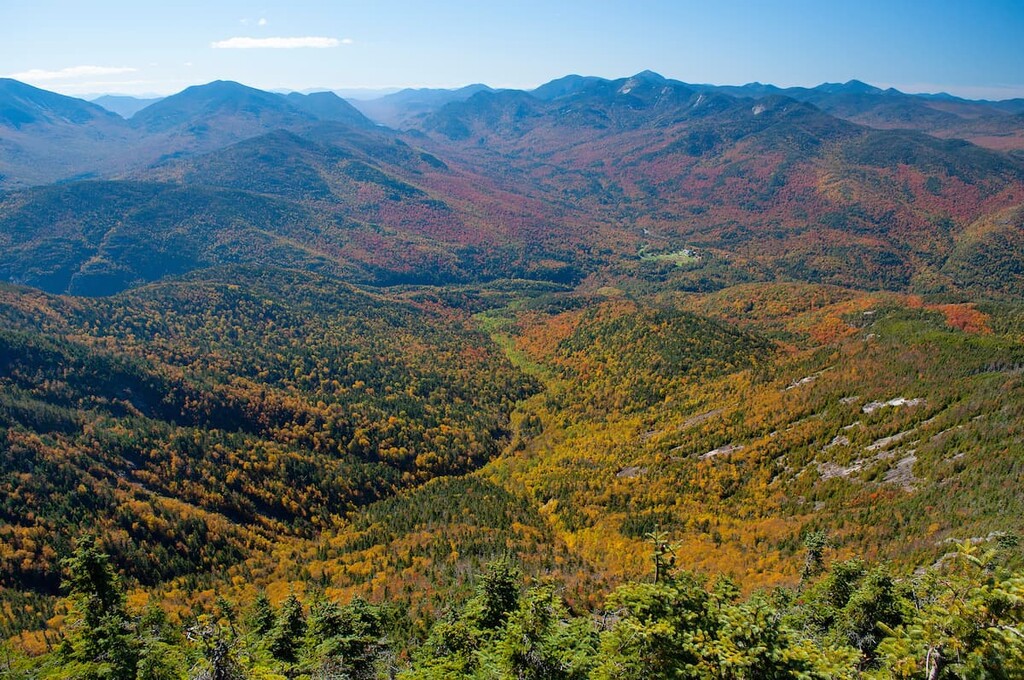Get PeakVisor App
Sign In
Search by GPS coordinates
- Latitude
- ° ' ''
- Longitude
- ° ' ''
- Units of Length

Yes
Cancel
Share ×

Scan the QR code and open PeakVisor on your phone
❤ Wishlist ×
Choose
Delete
The Adirondack High Peaks have drawn hikers for generations with their rugged beauty and tough climbs. If you’re looking for a unique, historic challenge, or just an excuse to climb some of the most beautiful mountains in the northeastern US, hiking the 46 Adirondack High Peaks is for you.

Hikers who’ve officially summited all of the peaks, known as ADK 46ers, Forty-Sixers, or just 46ers, are a storied group in the Adirondacks. Joining their ranks is a bucket list of peak ascents for hikers from all over the country. With the Peak Visor app, you can take on the High Peaks and start your own journey to becoming a 46er.
All of the 46 High Peaks are located in the Adirondack Park, with the majority situated within the High Peaks Wilderness in the north central area of the park. The Adirondack Park covers a substantial amount of Upstate New York, with the High Peaks lying at roughly the same latitude as the highest mountains in Vermont and New Hampshire.
In the early 1900s, the 46 High Peaks were originally believed to be all the peaks at or above 4,000 ft (1,219 m), but modern surveying has shown four of the peaks (Blake Peak, Cliff, Nye, and Couchsachraga) are actually below that elevation, and one excluded mountain (MacNaughton) is higher.
Regardless of this surveying issue, the mountains that make up the ‘official’ High Peaks today are the original 46.
Two of the High Peaks—Mount Marcy and Algonquin Peak—reach above 5,000 (1,524 m) ft in elevation. Mount Marcy is also both the tallest peak in the Adirondacks and in all of New York.

While it’s only the fifth highest peak, Whiteface Mountain is the second most prominent mountain of the 46ers after Mount Marcy. Whiteface is also one of one of the only developed peaks in the region. It’s home to a ski resort and auto road that reaches near the summit. (Although climbing to the peak from the road doesn’t count towards your ADK 46 badge.)
If you’re planning to take on the 46 Adirondack High Peaks, the Peak Visor app is a great asset for the challenge. You can use the app to log your climbs, learn about the mountains around you on the trail and plan your next peak bagging adventure.
The High Peaks are each marked with a special badge in the Peak Visor app, so it’s easy to see your progress. (Keep in mind that you’ll have to register with the ADK46ers and follow their guidelines for documenting climbs to become an official 46er)
The ADK 46ers are a group of hikers who have climbed the 46 High Peaks of the Adirondacks. Members of the nonprofit also volunteer to maintain trails and help educate others about proper wilderness usage.
Within the group, there are two distinctions: regular 46ers, who completed their hikes in any season, and Winter 46ers, who hiked every High Peak during the official winter season between December 21 to March 21.
There are over 13,000 registered 46ers today. But, the Winter 46ers are a much more exclusive group, with only 971 winter completions on record.

Climbing the 46 High Peaks is a serious challenge, but it’s achievable by most hikers with good preparation and patience. The record-holders for youngest and oldest 46ers were 4 and 82, respectively, when they completed the challenge.
The High Peaks vary widely in difficulty. Some peaks, such as Cascade and Porter, can be climbed in a relatively moderate day hike, while others, like Allen, are deep in the wilderness and require long treks just to reach the base of the mountain.
Many of these mountains have round trip hikes over 10 miles (16.1 km) with more than 3,000 ft (914 m) of climbing. In fact, completing the whole 46 peak set entails over 145,000 ft (44,200 m) of total elevation change.
However, there are plenty of less challenging High Peaks. Cascade Mountain is a popular first climb because it’s relatively short with a great payoff of 360-degree views at the top. The trail gains 1,940 ft (591 m) across 4.8 miles (7.7 km) and takes only about five hours round trip.

At the opposite end of the spectrum, summiting Rocky Peak Ridge requires 4,500 ft (1,372 m) of elevation change (the most of any single-mountain climb in the High Peaks). Mount Donaldson is a 17 mile (27.4 km), estimated 17 hour hike. Opinions differ on which peak is the hardest, but Mount Haystack and Mount Skylight are common choices.
These remote mountains are often hiked as overnight trips linked with other peaks in the area. The four High Peaks of the isolated Seward Range make for a good 28 mile (45 km) weekend trip. The premiere long distance trail in the area is the Great Range Traverse, a punishing 23 mile (37 km) trek that takes you over eight High Peaks and finishes with Mount Marcy.
The variation here means there’s something in the High Peaks for everyone. Less seasoned hikers can start with easier peaks and progress to more challenging climbs. Many hikers take years or even decades to cross them all off—there’s no time limit to complete the challenge.

Being an official 46er is about more than just hiking the mountains. You have to register with the ADK46ers (for an initial fee of $15) and document your climbs through the club’s charmingly old school record-keeping system. All peak-bagging documentation is done by mail.
After you’ve completed all the hikes, you can fill out the form on the ADK46ers website and mail it to the club historian. When your climbs are certified, you’ll receive a letter of congratulations in the mail with your “climbing number,” which is your place in the order of official 46ers.
All of the 13,000 official 46ers are part of a long tradition stretching back over 100 years. The idea to hike all the Adirondack Mountains above 4,000 ft (1,219 m) began with brothers Robert and George Marshall in 1918, when they hiked Whiteface Mountain along with their friend and guide, Herbert Clark.

At the time, this was a serious undertaking. Only 12 of the 46 High Peaks had trails to the summit. The climbs required serious bushwacking and navigation. It took the trio seven years to finish the project. They summited their last High Peak, Mount Emmons, on June 10, 1925. Today, Herbert Clark is listed 46er #1, George Marshall is #2 and Robert Marshall is #3. (Hikers’ climbing numbers are listed after their names in club literature.)
Robert (who is better known as Bob Marshall of Bob Marshall Wilderness Area fame) published a booklet detailing the trio’s expeditions in 1922, which caught the attention of the pastor and several parishioners at Grace Methodist Church in Troy, New York. Rev. Ernest Ryder (#7), along with Edward Hudowalski (#6) and Grace Hudowalski (#9) began taking the church’s Sunday school class on hikes in the Adirondacks during the 1930s and 1940s.
Grace Hudowalski became the first woman to summit all of the High Peaks. She also encouraged new members to keep records of their climbing accomplishments. As interest grew beyond the group’s social circle in Troy, the group officially formed the Adirondack 46ers.
Grace Hudowalski was elected president at the club’s inaugural meeting in 1948 and served for many years as club historian—the official record keeper of the ADK 46ers. Grace Peak in the Dix Range was renamed in her honor in 2014.
As of March 2020, there are 13,115 official 46ers, with more added every year.

If climbing the ADK46 isn’t enough peak bagging for you, there are other hiking challenges you can take on in Vermont, New Hampshire and Maine.
The Appalachian Mountain Club’s (AMC) Four Thousand Footer Club in New Hampshire is probably the best known and most challenging of the 4,000 ft clubs in New England. In order to join, hikers have to summit a total of 48 peaks in New Hampshire, including 6,289 ft (1,917 m) Mount Washington.
Nearby Maine has 14 peaks above 4,000 ft (1,219 m) and Vermont has five. If you hike all 67 of the 4,000 footers in New England, you can register your peak bagging with the AMC and earn a patch. To go one step further, there’s another badge for hikers who’ve completed the 100 Highest Peaks in New England.

Hikers should be aware that not all of the 46 peaks have official trails to the summit. Twenty of the peaks only have herd paths, which are unmaintained trails that have developed over time. Most are well worn-in and fairly easy to navigate, but always bring a map and compass if you’re going to be venturing off-trail, especially in the winter months.
The Adirondacks are immensely popular and increasingly crowded. Be prepared for lots of other hikers on the trails, particularly at the most famous High Peaks.
While the Adirondack Park doesn’t currently have entry fees or permitting requirements for day hikers, some places charge for parking, and one trailhead on Route 73 has recently gone to a reservation system. Plan accordingly and arrive early if you want to be sure you’ll find parking.
While dispersed camping is allowed in many parts of the Adirondacks, it’s prohibited above 4,000 ft (1,219 m) in the park. Fires are not allowed in the Eastern Zone of the High Peaks Wilderness, and hikers are required to use bear canisters during the spring, summer and fall.

If you’re heading into the High Peaks, respect the wilderness and stay on the trail, especially in the high-alpine areas above 4,000 ft (1,219 m). These are some of the most unique ecosystems in the northeast, and they’re exceptionally delicate. The summit of Mount Marcy in particular has already lost some of its alpine vegetation due to overuse.
Overall, enjoy your time in the High Peaks and help keep them beautiful for those who’ll come after you.
Explore 46 Adirondack High Peaks with the PeakVisor 3D Map and identify its summits.
ahp46
northeast-115-4000ers
adirondack-top-100
fred-beckey-great-peaks
ahp46
northeast-115-4000ers
adirondack-top-100
fred-beckey-great-peaks
